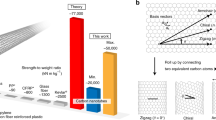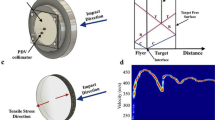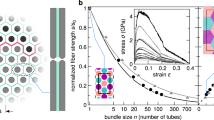Abstract
The excellent mechanical properties of carbon nanotubes are being exploited in a growing number of applications from ballistic armour to nanoelectronics. However, measurements of these properties have not achieved the values predicted by theory due to a combination of artifacts introduced during sample preparation and inadequate measurements. Here we report multiwalled carbon nanotubes with a mean fracture strength >100 GPa, which exceeds earlier observations by a factor of approximately three. These results are in excellent agreement with quantum-mechanical estimates for nanotubes containing only an occasional vacancy defect, and are ∼80% of the values expected for defect-free tubes. This performance is made possible by omitting chemical treatments from the sample preparation process, thus avoiding the formation of defects. High-resolution imaging was used to directly determine the number of fractured shells and the chirality of the outer shell. Electron irradiation at 200 keV for 10, 100 and 1,800 s led to improvements in the maximum sustainable loads by factors of 2.4, 7.9 and 11.6 compared with non-irradiated samples of similar diameter. This effect is attributed to crosslinking between the shells. Computer simulations also illustrate the effects of various irradiation-induced crosslinking defects on load sharing between the shells.
This is a preview of subscription content, access via your institution
Access options
Subscribe to this journal
Receive 12 print issues and online access
$259.00 per year
only $21.58 per issue
Buy this article
- Purchase on Springer Link
- Instant access to full article PDF
Prices may be subject to local taxes which are calculated during checkout





Similar content being viewed by others
References
Ogata, S. & Shibutani, Y. Ideal tensile strength and band gap of single-walled carbon nanotubes. Phys. Rev. B 68, 165409 (2003).
Ozaki, T., Iwasa, Y. & Mitani, T. Stiffness of single-walled carbon nanotubes under large strain. Phys. Rev. Lett. 84, 1712–1715 (2000).
Dumitrica, T., Belytschko, T. & Yakobson, B. I. Bond-breaking bifurcation states in carbon nanotube fracture. J. Chem. Phys. 118, 9485–9488 (2003).
Mielke, S. L. et al. The role of vacancy defects and holes in the fracture of carbon nanotubes. Chem. Phys. Lett. 390, 413–420 (2004).
Troya, D., Mielke, S. L. & Schatz, G. C. Carbon nanotube fracture—differences between quantum mechanical mechanisms and those of empirical potentials. Chem. Phys. Lett. 382, 133–141 (2003).
Yu, M. F. et al. Strength and breaking mechanism of multiwalled carbon nanotubes under tensile load. Science 287, 637–640 (2000).
Ding, W. et al. Modulus, fracture strength and brittle vs. plastic response of the outer shell of arc-grown multi-walled carbon nanotubes. Exp. Mech. 47, 25–36 (2007).
Barber, A. H., Kaplan-Ashiri, I., Cohen, S. R., Tenne, R. & Wagner, H. D. Stochastic strength of nanotubes: An appraisal of available data. Compos. Sci. Technol. 65, 2380–2384 (2005).
Barber, A. H., Andrews, R., Schadler, L. S. & Wagner, H. D. On the tensile strength distribution of multiwalled carbon nanotubes. Appl. Phys. Lett. 87, 203106 (2005).
Zhang, S. et al. Mechanics of defects in carbon nanotubes: Atomistic and multiscale simulations. Phys. Rev. B 71, 115403 (2005).
Mielke, S. L. et al. The effects of extensive pitting on the mechanical properties of carbon nanotubes. Chem. Phys. Lett. 446, 128–132 (2007).
Mølhave, K. et al. Electron irradiation-induced destruction of carbon nanotubes in electron microscopes. Ultramicroscopy 108, 52–57 (2007).
Andrews, R., Jacques, D., Qian, D. & Dickey, E. C. Purification and structural annealing of multiwalled carbon nanotubes at graphitization temperatures. Carbon 39, 1681–1687 (2001).
Haddon, R. C., Sippel, J., Rinzler, A. G. & Papadimitrakopoulos, F. Purification and separation of carbon nanotubes. MRS Bull. 29, 252–259 (2004).
Mawhinney, D. B. et al. Surface defect site density on single walled carbon nanotubes by titration. Chem. Phys. Lett. 324, 213–216 (2000).
Hashimoto, A., Suenaga, K., Gloter, A., Urita, K. & Iijima, S. Direct evidence for atomic defects in graphene layers. Nature 430, 870–873 (2004).
Suenaga, K. et al. Imaging active topological defects in carbon nanotubes. Nature Nanotech. 2, 358–360 (2007).
Yakobson, B. I. Mechanical relaxation and ‘intramolecular plasticity’ in carbon nanotubes. Appl. Phys. Lett. 72, 918–920 (1998).
Nardelli, M. B., Yakobson, B. I. & Bernholc, J. Mechanism of strain release in carbon nanotubes. Phys. Rev. B 57, R4277–R4280 (1998).
Stone, A. J. & Wales, D. J. Theoretical-studies of icosahedral C60 and some related species. Chem. Phys. Lett. 128, 501–503 (1986).
Banhart, F. Irradiation effects in carbon nanostructures. Rep. Prog. Phys. 62, 1181–1221 (1999).
Kis, A. et al. Reinforcement of single-walled carbon nanotube bundles by intertube bridging. Nature Mater. 3, 153–157 (2004).
Sammalkorpi, M., Krasheninnikov, A., Kuronen, A., Nordlund, K. & Kaski, K. Mechanical properties of carbon nanotubes with vacancies and related defects Phys. Rev. B 70, 245416 (2004).
Huhtala, M. et al. Improved mechanical load transfer between shells of multiwalled carbon nanotubes. Phys. Rev. B 70, 045404 (2004).
Espinosa, H. D., Zhu, Y. & Moldovan, N. Design and operation of a MEMS-based material testing system for in-situ electron microscopy testing of nanostructures. J. Microelectromech. S. 16, 1219–1231 (2007).
Zhu, Y., Moldovan, N. & Espinosa, H. D. A microelectromechanical load sensor for in situ electron and X-ray microscopy tensile testing of nanostructures. Appl. Phys. Lett. 86, 013506 (2005).
Zhu, Y. & Espinosa, H. D. An electromechanical material testing system for in situ electron microscopy and applications. Proc. Natl Acad. Sci. USA 102, 14503–14508 (2005).
Zhu, Y., Corigliano, A. & Espinosa, H. D. A thermal actuator for nanoscale in-situ microscopy testing: Design and characterization. J. Micromech. Microeng. 16, 242–253 (2006).
Smith, B. W. & Luzzi, D. E. Electron irradiation effects in single wall carbon nanotubes. J. Appl. Phys. 90, 3509–3515 (2001).
Endo, M. et al. Stacking nature of graphene layers in carbon nanotubes and nanofibres. J. Phys. Chem. Solids 58, 1707–1712 (1997).
Qin, L.-C. Electron diffraction from carbon nanotubes. Rep. Prog. Phys. 69, 2761–2821 (2006).
Stewart, J. J. P. Optimization of parameters for semi-empirical methods. I. Method. J. Comp. Chem. 10, 209–220 (1989).
Brenner, D. W. et al. A second-generation reactive empirical bond order (REBO) potential energy expression for hydrocarbons. J. Phys. Condens. Matter 14, 783–802 (2002).
Shenderova, O. A., Brenner, D. W., Omeltchenko, A., Su, X. & Yang, L. H. Atomistic modelling of the fracture of polycrystalline diamond. Phys. Rev. B 61, 3877–3888 (2000).
Elstner, M. et al. Self-consistent-charge density-functional tight-binding method for simulations of complex materials properties. Phys. Rev. B 58, 7260–7268 (1998).
Zobelli, A., Gloter, A., Ewels, C. P., Seifert, G. & Colliex, C. Electron knock-on cross-section of carbon and boron nitride nanotubes. Phys. Rev. B 75, 245402 (2007).
Krasheninnikov, A. V., Nordlund, K., Sirvio, M., Salonen, E. & Keinonen, J. Formation of ion-irradiation-induced atomic-scale defects on walls of carbon nanotubes. Phys. Rev. B 63, 245405 (2001).
Gomez-Navarro, C. et al. Tuning the conductance of single-walled carbon nanotubes by ion irradiation in the Anderson localization regime. Nature Mater. 4, 534–539 (2005).
Bockrath, M. et al. Resonant electron scattering by defects in single-walled carbon nanotubes. Science 291, 283–285 (2001).
Charlier, J.-C., Blase, X. & Roche, S. Electronic and transport properties of nanotubes. Rev. Mod. Phys. 79, 677–732 (2007).
Telling, R. H., Ewels, C. P., El Barbary, A. A. & Heggie, M. I. Wigner defects bridge the graphite gap. Nature Mater. 2, 333–337 (2003).
Acknowledgements
Financial support for this work was provided by the National Science Foundation (CMMI 0555734 and CHE-0550497) and the Office of Naval Research (N000140710905 and N000140810108). The tests were performed at the Electron Probe Instrumentation Centre (EPIC) at Northwestern University. The authors thank I. Petrov and E. Olson for their contribution in the development of the in situ TEM holder. G.C.S. and S.L.M. acknowledge the NASA University Research, Engineering and Technology Institute on Bio Inspired Materials (NCC-1-02037). P.Z., and use of the Centre for Nanoscale Materials at Argonne National Laboratory, were supported by the Department of Energy (DE-AC02-06CH11357).
Author information
Authors and Affiliations
Contributions
H.E. conceived and designed the experiments. B.P. and S.L. performed the experiments. H.E., P.Z., G.S. and M.L. conceived the simulations. All authors analysed the data. S.M. contributed analysis tools. All authors discussed the results and co-wrote and commented on the manuscript. B.P. and M.L. contributed equally to this work.
Corresponding author
Rights and permissions
About this article
Cite this article
Peng, B., Locascio, M., Zapol, P. et al. Measurements of near-ultimate strength for multiwalled carbon nanotubes and irradiation-induced crosslinking improvements. Nature Nanotech 3, 626–631 (2008). https://doi.org/10.1038/nnano.2008.211
Received:
Accepted:
Published:
Issue Date:
DOI: https://doi.org/10.1038/nnano.2008.211
This article is cited by
-
Giant nanomechanical energy storage capacity in twisted single-walled carbon nanotube ropes
Nature Nanotechnology (2024)
-
Durability and Fractal Analysis of Pore Structure of Crumb Rubber Concrete Modified with Carbon Nanotubes
Arabian Journal for Science and Engineering (2023)
-
Nanocarbon-Infused Metal Matrix Composites: A Review
JOM (2023)
-
Frictional sliding of cylindrical punch on gradient nanostructured material coating
Acta Mechanica (2023)
-
Fabrication and Performance of Multi-wall Carbon Nanotubes Reinforced Polyimide Electrospun Nanofiber Membranes
Fibers and Polymers (2023)



